Extraction of Roof Feature Lines Based on Geometric Constraints from Airborne LiDAR Data
Abstract
:1. Introduction
2. Related Work
3. Materials and Methods
3.1. Datasets Description
3.2. Extraction of External Feature Lines
3.2.1. Coarse Roof Outlines
3.2.2. Refined Roof Outlines
- ①
- ②
- ③
3.3. Extraction of Internal Feature Lines
3.3.1. Normal Ridge Lines
- ①
- Given a set of normal ridge points , and the two points with the farthest planar distance can be selected. Take one of these two points as the center of a circle, as shown in in (a) and in (b).
- ②
- Several lines passing through can be plotted, where and ranges from 0 to 175 degrees at intervals of 5 degrees. A total of 35 lines can be determined.
- ③
- For each line , the initial set of normal ridge points belongs to can be obtained by calculating the distance between each point and . If the distance is smaller than the average point spacing, the corresponding point is considered as an initial normal ridge point. Project all points in onto . Take as the beginning point, and calculate the distance between two adjacent points in one direction successively. If the distance is greater than twice the average point spacing (an empirical value), the remaining points that have not been calculated should be eliminated from . Then, can be determined.
- ④
- Among those lines passing through , a certain line with the most points should be selected. The final line can be fitted by the corresponding points using gradient descent method and those points should be labeled.
- ⑤
- For the remaining unlabeled points in S, repeat steps ① to ④ until the number of unlabeled points is fewer than 2. It is noteworthy that for the points located at the intersection area of two normal ridge lines, the reusing strategy is adapted to guarantee the completeness of each normal ridge line.
3.3.2. Oblique Ridge Lines and Valley Lines
- ①
- If there exists normal ridge points or outline points near to the corresponding end points, then the new end points of the corresponding feature line should be replaced by the end points of the determined normal ridge line or outline.
- ②
- If there are edge points and no end points of outlines, linear fitting is adapted for all points in . If one end point has been determined, translate the fitted line to pass through the determined end point. The other end point can be acquired by intersection.
- ③
- Otherwise, all points are used to fit a feature line and projected onto the line to obtain the corresponding end points.
4. Experiments and Discussion
5. Conclusions
Author Contributions
Funding
Data Availability Statement
Acknowledgments
Conflicts of Interest
References
- Du, S.J.; Zhang, Y.S.; Zou, Z.R.; Xu, S.H.; He, X.; Chen, S.Y. Automatic building extraction from LiDAR data fusion of point and grid-based features. ISPRS-J. Photogramm. Remote Sens. 2017, 130, 294–307. [Google Scholar] [CrossRef]
- Yang, B.S.; Huang, R.G.; Li, J.P.; Tian, M.; Dai, W.X.; Zhong, R.F. Automated Reconstruction of Building LoDs from Airborne LiDAR Point Clouds Using an Improved Morphological Scale Space. Remote Sensing 2017, 9, 14. [Google Scholar] [CrossRef]
- Salehi, A.; Mohammadzadeh, A. Building Roof Reconstruction Based on Residue Anomaly Analysis and Shape Descriptors from Lidar and Optical Data. Photogramm. Eng. Remote Sens. 2017, 83, 281–292. [Google Scholar] [CrossRef]
- Griffiths, D.; Boehm, J. Improving public data for building segmentation from Convolutional Neural Networks (CNNs) for fused airborne lidar and image data using active contours. ISPRS-J. Photogramm. Remote Sens. 2019, 154, 70–83. [Google Scholar] [CrossRef]
- Sampath, A.; Shan, J. Building boundary tracing and regularization from airborne lidar point clouds. Photogramm. Eng. Remote Sens. 2007, 73, 805–812. [Google Scholar] [CrossRef]
- Sun, S.H.; Salvaggio, C. Aerial 3D Building Detection and Modeling from Airborne LiDAR Point Clouds. IEEE J. Sel. Top. Appl. Earth Obs. Remote Sens. 2013, 6, 1440–1449. [Google Scholar] [CrossRef]
- dos Santos, R.C.; Galo, M.; Carrilho, A.C. Extraction of Building Roof Boundaries from LiDAR Data Using an Adaptive Alpha-Shape Algorithm. IEEE Geosci. Remote Sens. Lett. 2019, 16, 1289–1293. [Google Scholar] [CrossRef]
- Feng, M.L.; Zhang, T.G.; Li, S.C.; Jin, G.Q.; Xia, Y.J. An improved minimum bounding rectangle algorithm for regularized building boundary extraction from aerial LiDAR point clouds with partial occlusions. Int. J. Remote Sens. 2020, 41, 300–319. [Google Scholar] [CrossRef]
- Yang, J.T.; Kang, Z.Z.; Akwensi, P.H. A Label-Constraint Building Roof Detection Method from Airborne LiDAR Point Clouds. IEEE Geosci. Remote Sens. Lett. 2021, 18, 1466–1470. [Google Scholar] [CrossRef]
- Kaplan, G.; Comert, R.; Kaplan, O.; Matci, D.K.; Avdan, U. Using Machine Learning to Extract Building Inventory Information Based on LiDAR Data. ISPRS Int. J. Geo-Inf. 2022, 11, 517. [Google Scholar] [CrossRef]
- Dey, E.K.; Awrangjeb, M.; Stantic, B. Outlier detection and robust plane fitting for building roof extraction from LiDAR data. Int. J. Remote Sens. 2020, 41, 6325–6354. [Google Scholar] [CrossRef]
- Wang, J.; Qin, Q.; Chen, L.; Ye, X.; Qin, X.; Wang, J.; Chen, C. Automatic building extraction from very high resolution satellite imagery using line segment detector. In Proceedings of the 2013 IEEE International Geoscience and Remote Sensing Symposium-IGARSS, Melbourne, VIC, Australia, 21–26 July 2013; pp. 212–215. [Google Scholar]
- Chen, K.; Zou, Z.; Shi, Z. Building Extraction from Remote Sensing Images with Sparse Token Transformers. Remote Sens. 2021, 13, 4441. [Google Scholar] [CrossRef]
- Baltsavias, E.P. Airborne Laser Scanning: Existing Systems and Firms and Other Resources. ISPRS-J. Photogramm. Remote Sens. 1999, 54, 164–198. [Google Scholar] [CrossRef]
- Li, L.; Song, N.; Sun, F.; Liu, X.Y.; Wang, R.S.; Yao, J.; Cao, S.S. Point2Roof: End-to-end 3D building roof modeling from airborne LiDAR point clouds. ISPRS-J. Photogramm. Remote Sens. 2022, 193, 17–28. [Google Scholar] [CrossRef]
- Sadeq, H.A.J. Building Extraction from Lidar Data Using Statistical Methods. Photogramm. Eng. Remote Sens. 2021, 87, 33–42. [Google Scholar] [CrossRef]
- Sampath, A.; Shan, J. Segmentation and Reconstruction of Polyhedral Building Roofs from Aerial Lidar Point Clouds. IEEE Trans. Geosci. Remote 2010, 48, 1554–1567. [Google Scholar] [CrossRef]
- Galvanin, E.A.D.; Dal Poz, A.P. Extraction of Building Roof Contours from LiDAR Data Using a Markov-Random-Field-Based Approach. IEEE Trans. Geosci. Remote Sens. 2012, 50, 981–987. [Google Scholar] [CrossRef]
- Cao, R.J.; Zhang, Y.J.; Liu, X.Y.; Zhao, Z.Z. 3D building roof reconstruction from airborne LiDAR point clouds: A framework based on a spatial database. Int. J. Geograph. Inf. Sci. 2017, 31, 1359–1380. [Google Scholar] [CrossRef]
- Lee, J.; Han, S.; Byun, Y.; Kim, Y. Extraction and Regularization of Various Building Boundaries with Complex Shapes Utilizing Distribution Characteristics of Airborne LIDAR Points. ETRI J. 2011, 33, 547–557. [Google Scholar] [CrossRef]
- Wang, R.S.; Hu, Y.; Wu, H.Y.; Wang, J. Automatic extraction of building boundaries using aerial LiDAR data. J. Appl. Remote Sens. 2016, 10, 016022. [Google Scholar] [CrossRef]
- Zhao, Z.Z.; Duan, Y.S.; Zhang, Y.J.; Cao, R.J. Extracting buildings from and regularizing boundaries in airborne lidar data using connected operators. Int. J. Remote Sens. 2016, 37, 889–912. [Google Scholar] [CrossRef]
- Sreevalsan-Nair, J.; Jindal, A.; Kumari, B. Contour Extraction in Buildings in Airborne LiDAR Point Clouds Using Multiscale Local Geometric Descriptors and Visual Analytics. IEEE J. Sel. Top. Appl. Earth Obs. Remote Sens. 2018, 11, 2320–2335. [Google Scholar] [CrossRef]
- Santos, R.C.d.; Pessoa, G.G.; Carrilho, A.C.; Galo, M. Automatic Building Boundary Extraction from Airborne LiDAR Data Robust to Density Variation. IEEE Geosci. Remote Sens. Lett. 2022, 19, 1–5. [Google Scholar] [CrossRef]
- Li, Y.; Wu, H.; An, R.; Xu, H.; He, Q.; Xu, J. An improved building boundary extraction algorithm based on fusion of optical imagery and LIDAR data. Optik 2013, 124, 5357–5362. [Google Scholar] [CrossRef]
- Cheng, L.G.; Chen, J.; Han, X.P. Building Boundary Extraction from High Resolution Imagery and Lidar Data. Int. Arch. Photogramm. Remote Sens. Spat. Inf. Sci. 2008, 37, 693–698. [Google Scholar]
- Sun, Y.; Zhang, X.C.; Zhao, X.Y.; Xin, Q.C. Extracting Building Boundaries from High Resolution Optical Images and LiDAR Data by Integrating the Convolutional Neural Network and the Active Contour Model. Remote Sens. 2018, 10, 1459. [Google Scholar] [CrossRef]
- Akbulut, Z.; Özdemir, S.; Acar, H.; Karsli, F. Automatic Building Extraction from Image and LiDAR Data with Active Contour Segmentation. J. Indian Soc. Remote 2018, 46, 2057–2068. [Google Scholar] [CrossRef]
- Awrangjeb, M. Using point cloud data to identify, trace, and regularize the outlines of buildings. Int. J. Remote Sens. 2016, 37, 551–579. [Google Scholar] [CrossRef]
- Zhang, D.; Du, P. 3D Building Reconstruction from Lidar Data Based on Delaunay TIN Approach; SPIE: St. Bellingham, WA, USA, 2011; Volume 8286. [Google Scholar]
- Edelsbrunner, H.; Kirkpatrick, D.; Seidel, R. On the shape of a set of points in the plane. IEEE Trans. Inf. Theory 1983, 29, 551–559. [Google Scholar] [CrossRef]
- Hofman, P.; Potůčková, M. Comprehensive approach for building outline extraction from LiDAR data with accent to a sparse laser scanning point cloud. Geoinform. FCE CTU 2017, 16, 91–102. [Google Scholar] [CrossRef]
- Cramer, M. The DGPF-test on digital airborne camera evaluation—Overview and test design. Photogramm.-Ernerkundung-Geoinf. 2010, 2010, 73–82. [Google Scholar] [CrossRef] [PubMed]

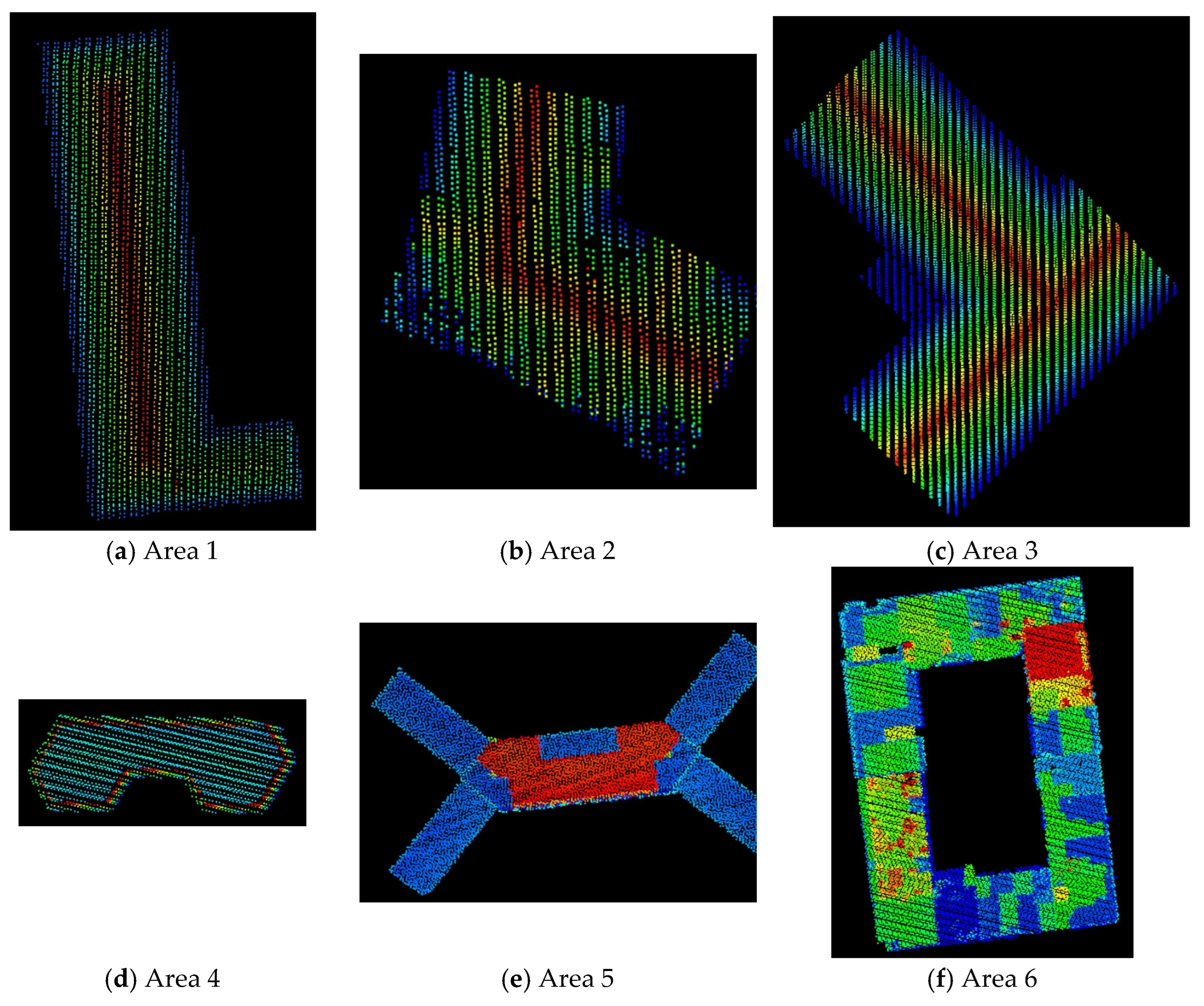
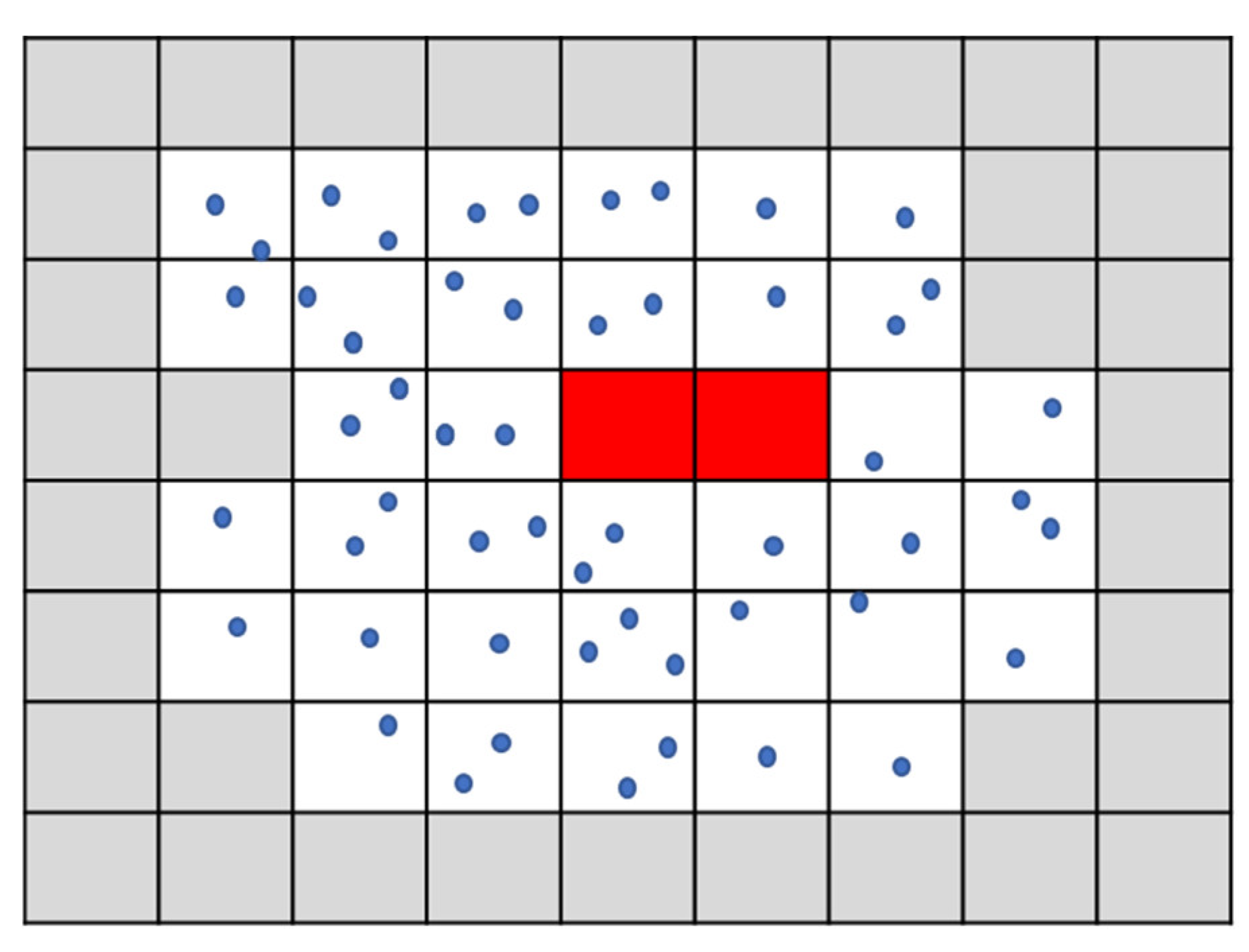


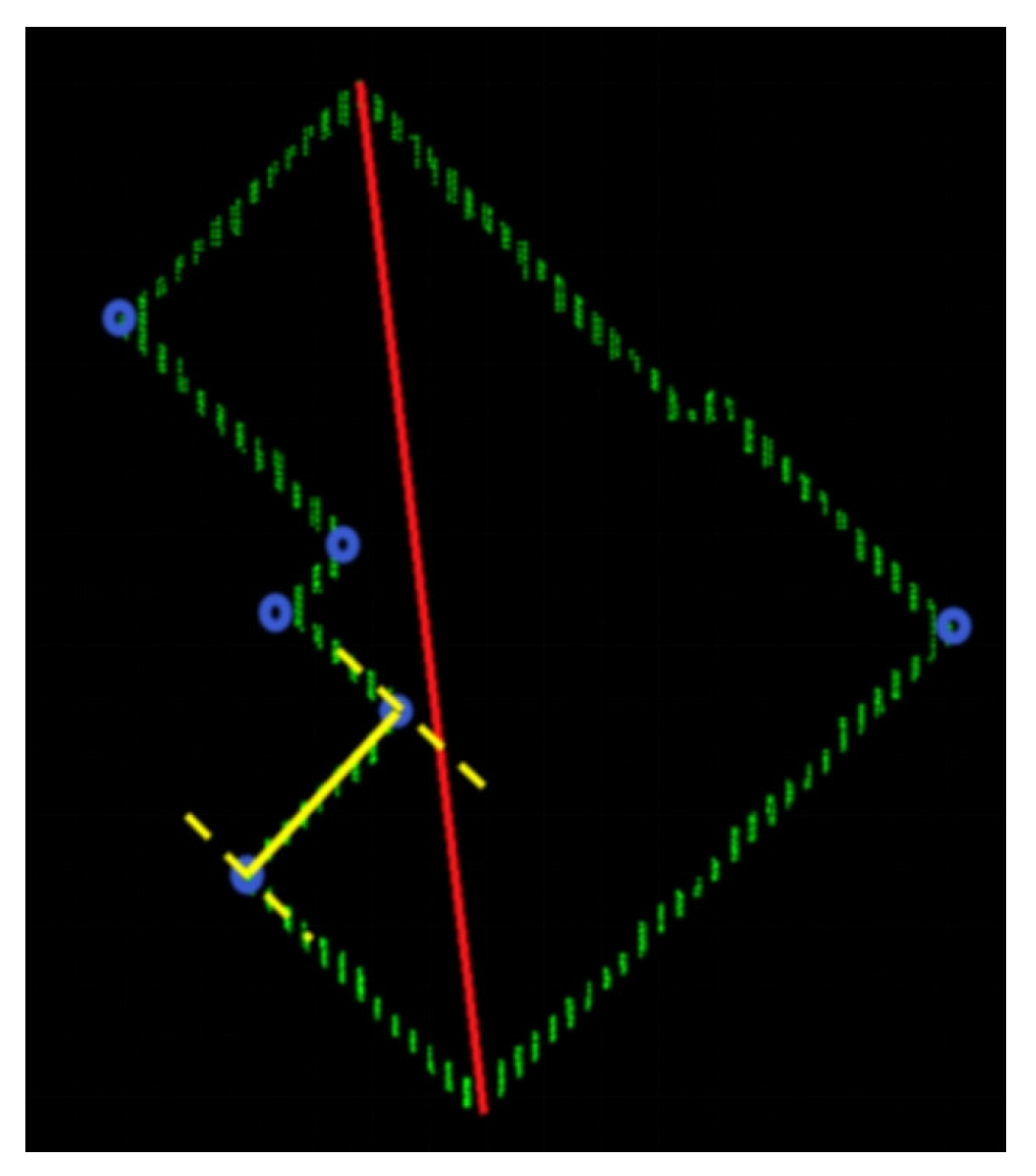
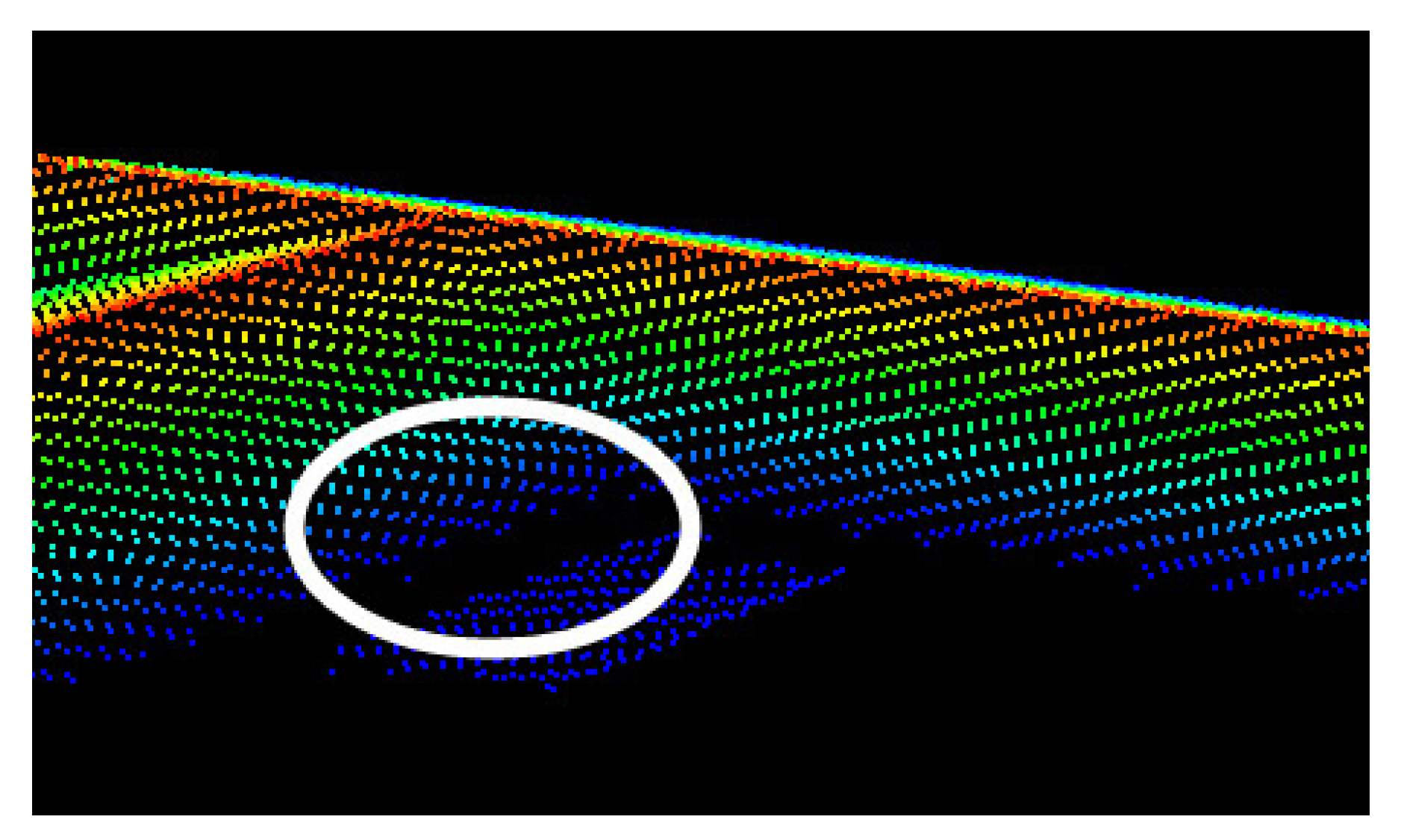
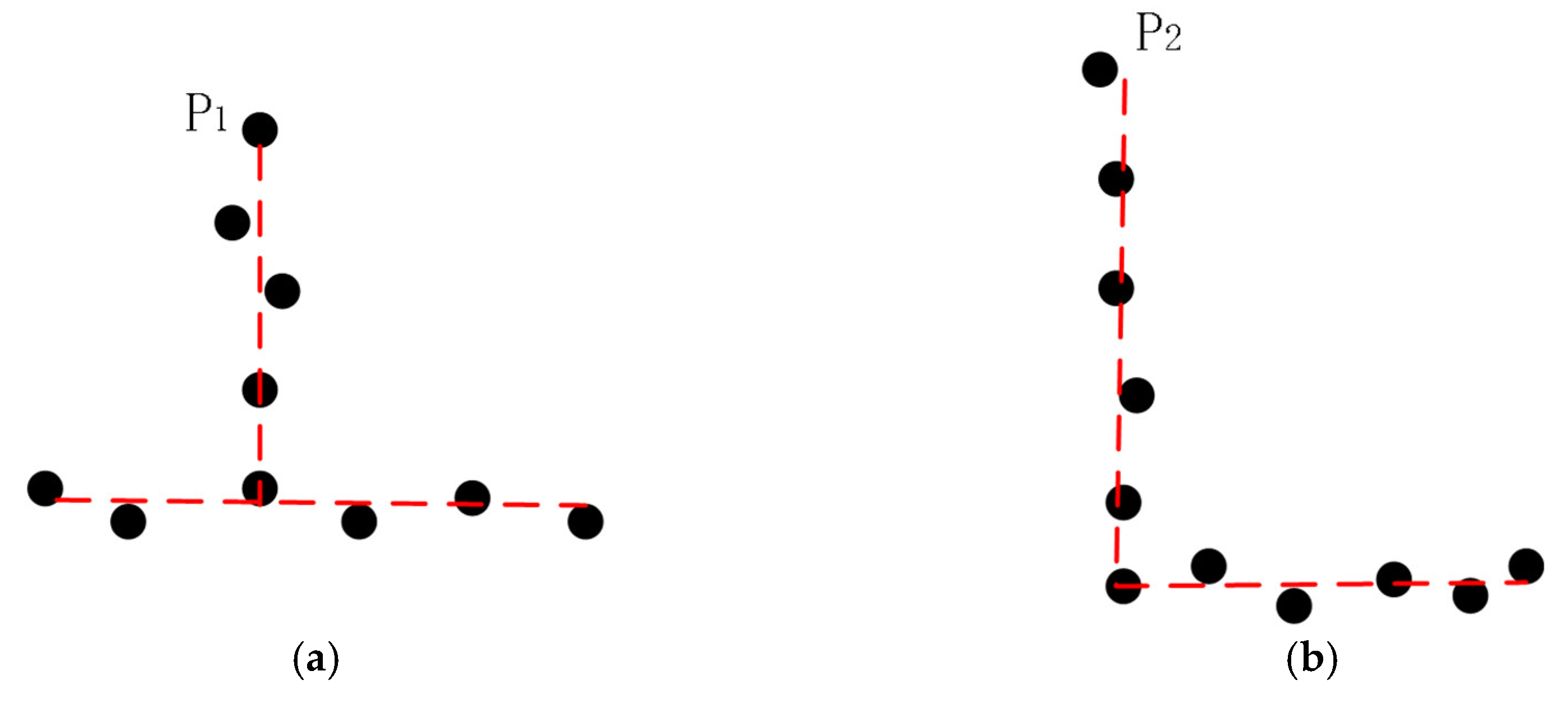

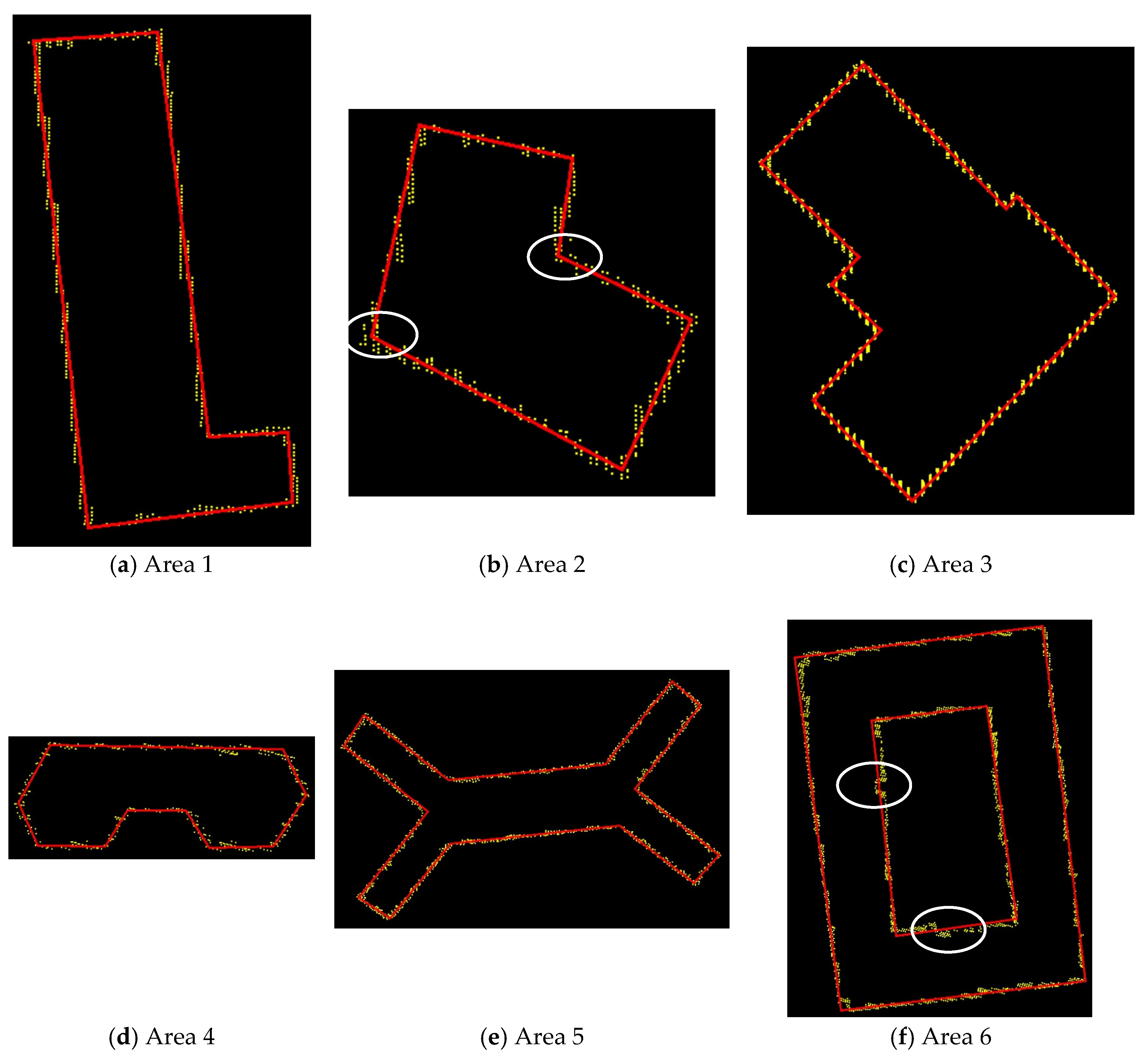
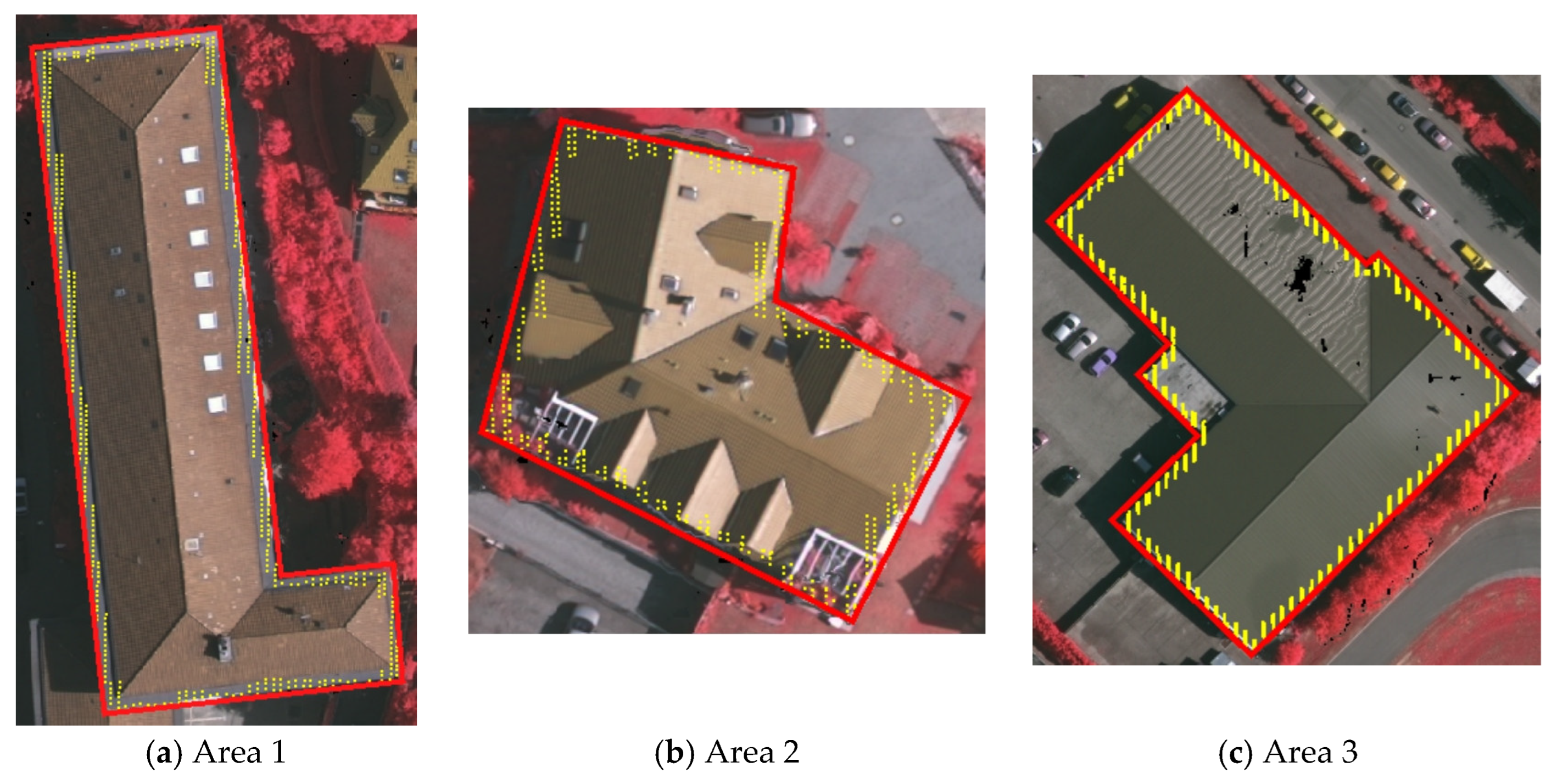
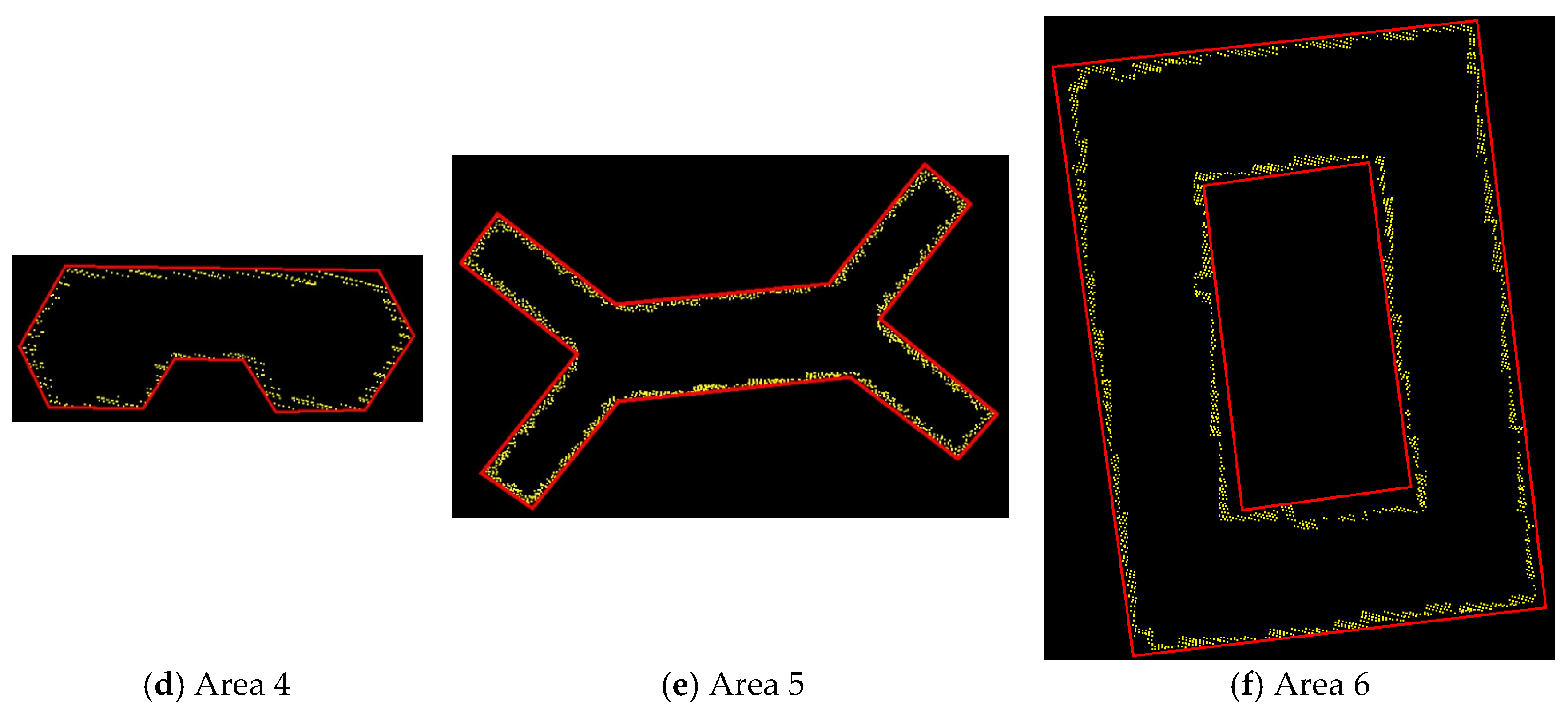
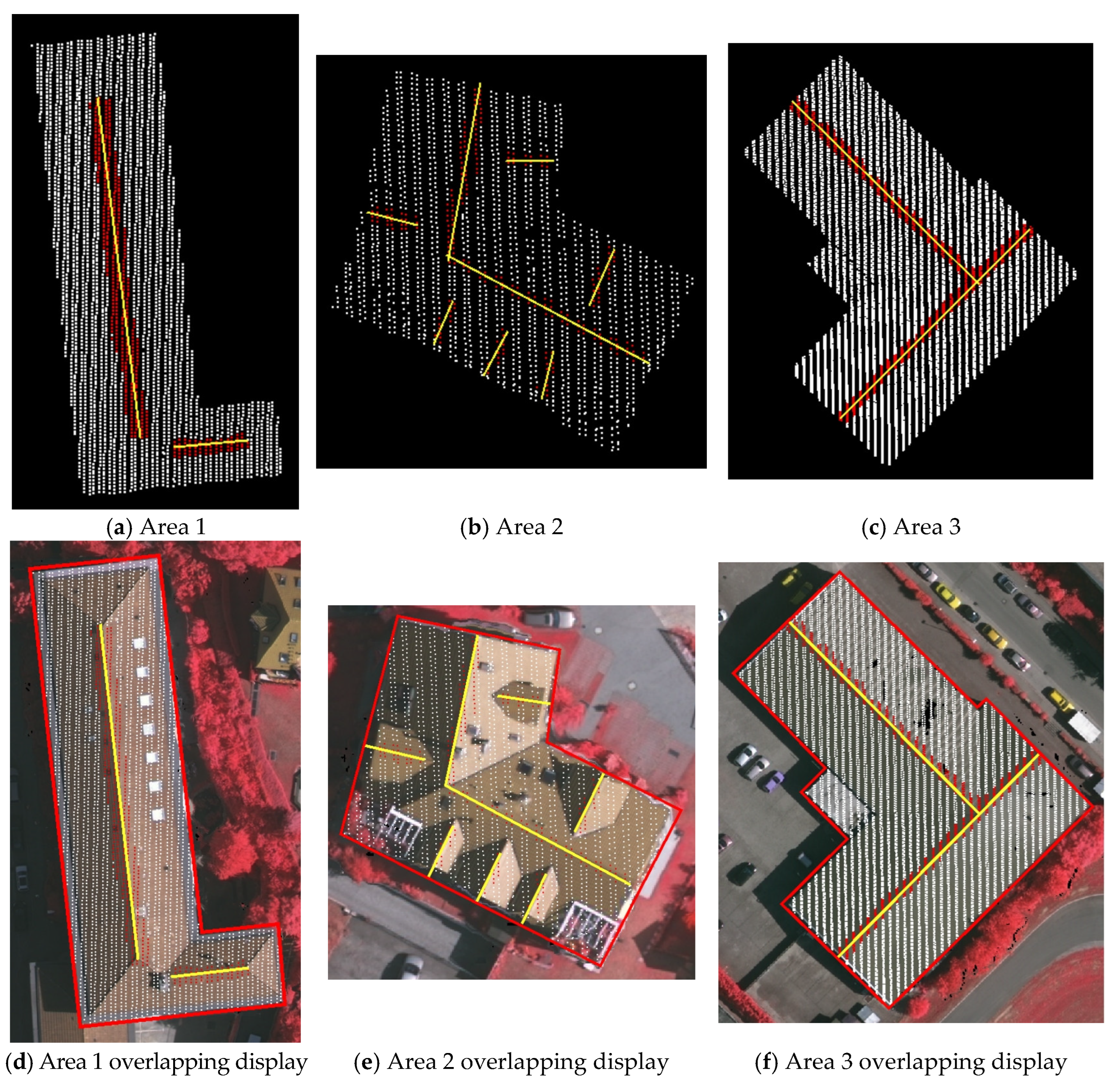
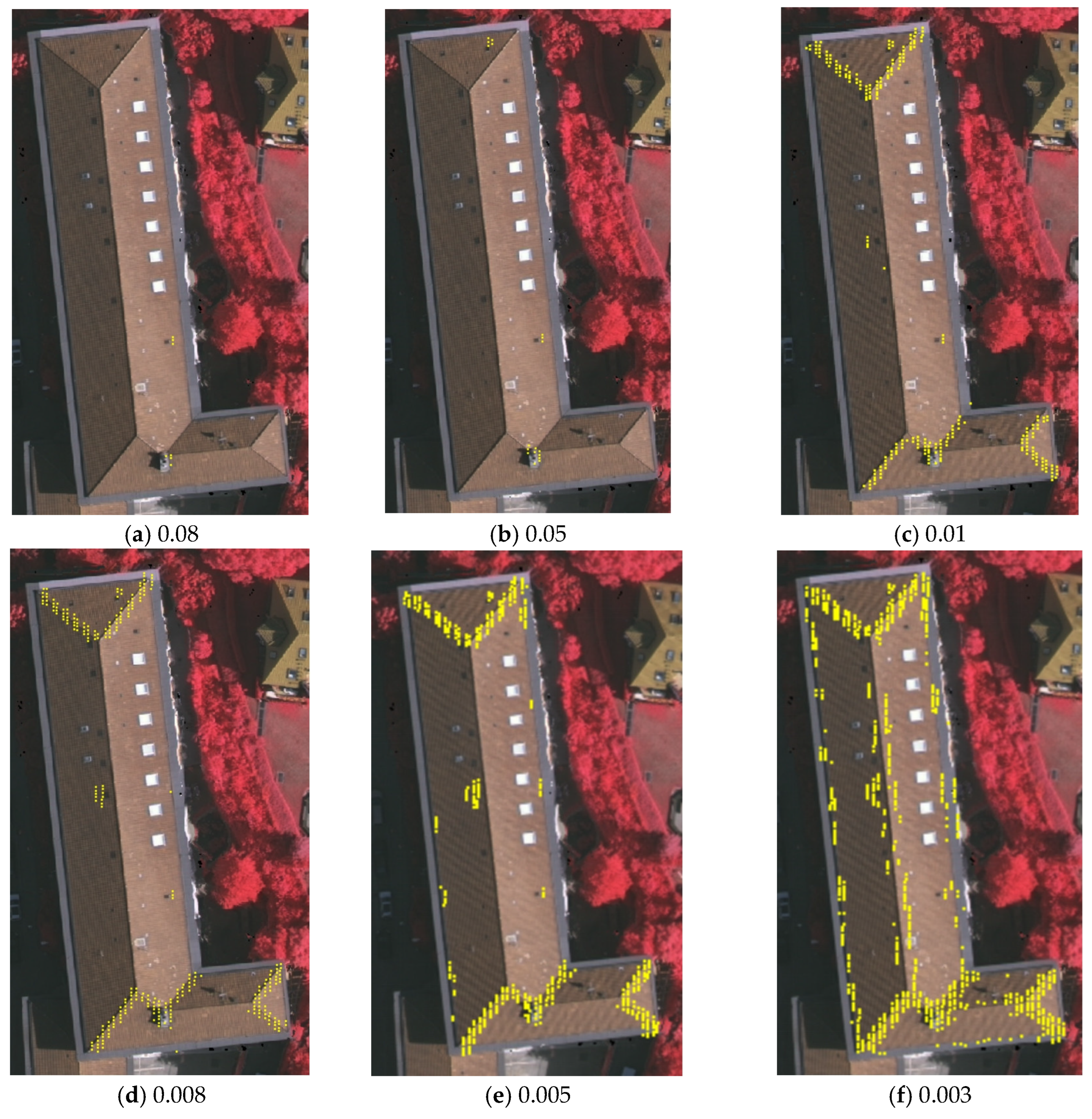

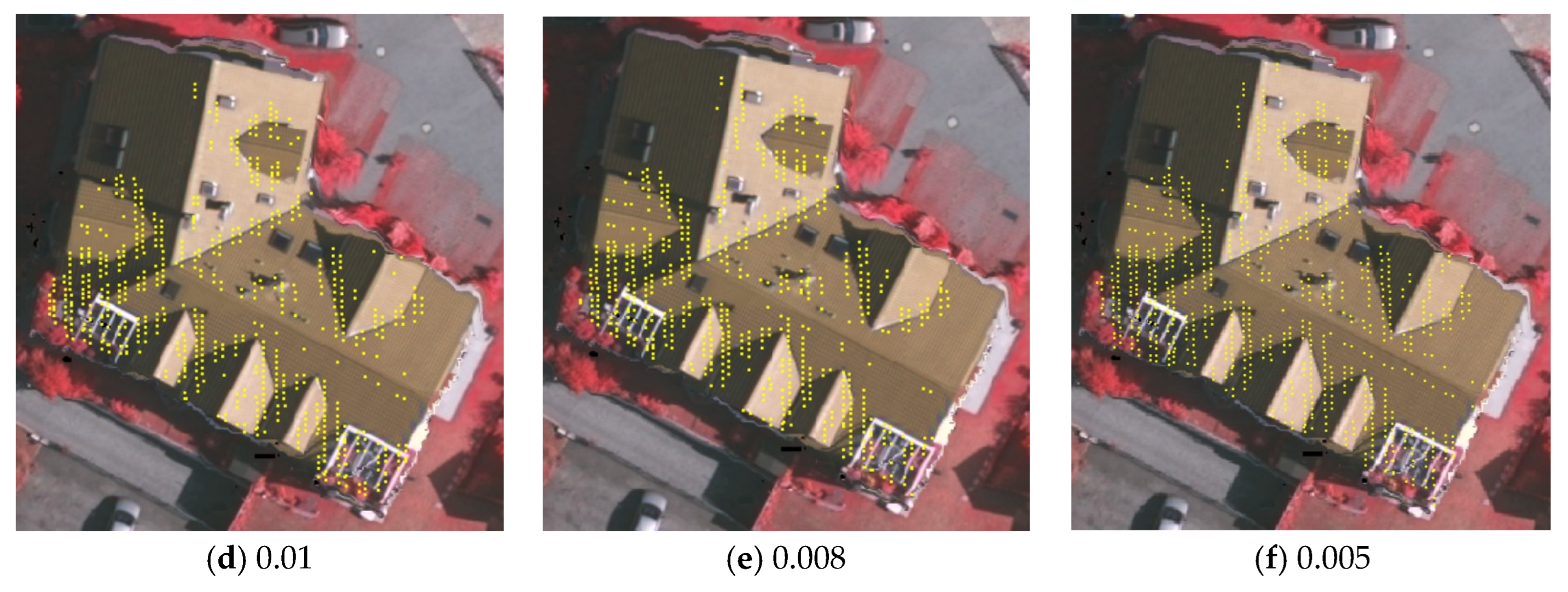
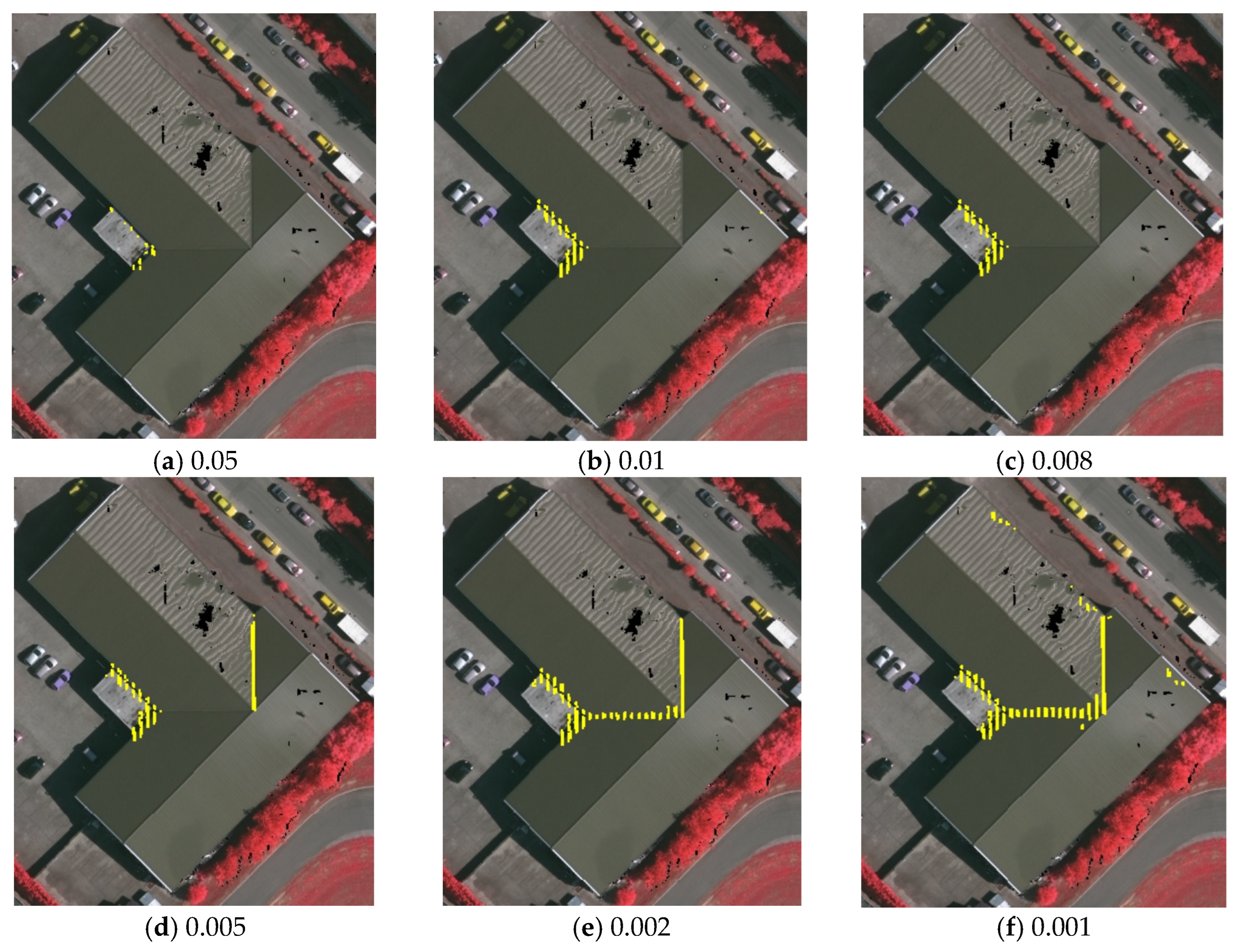
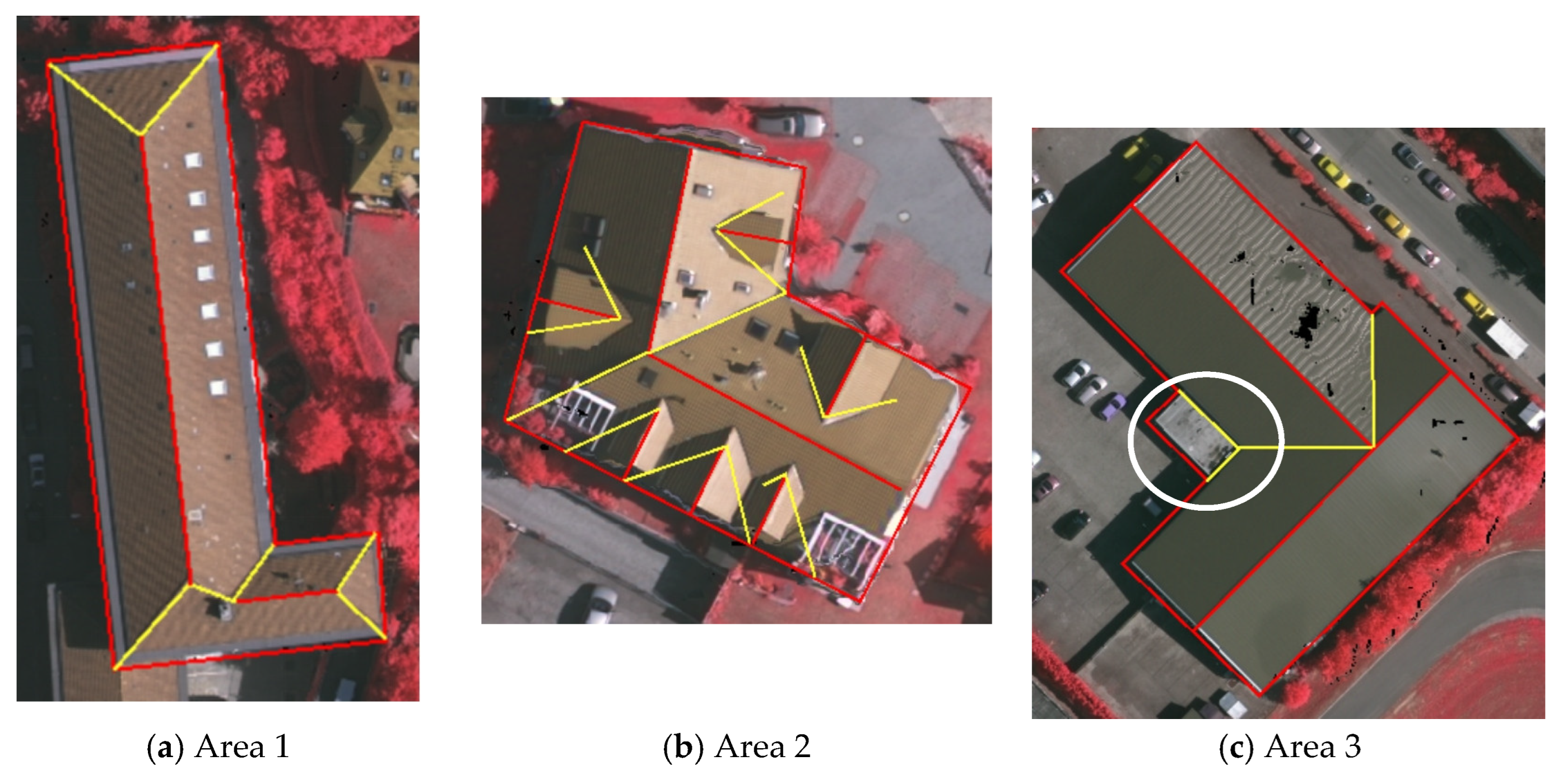
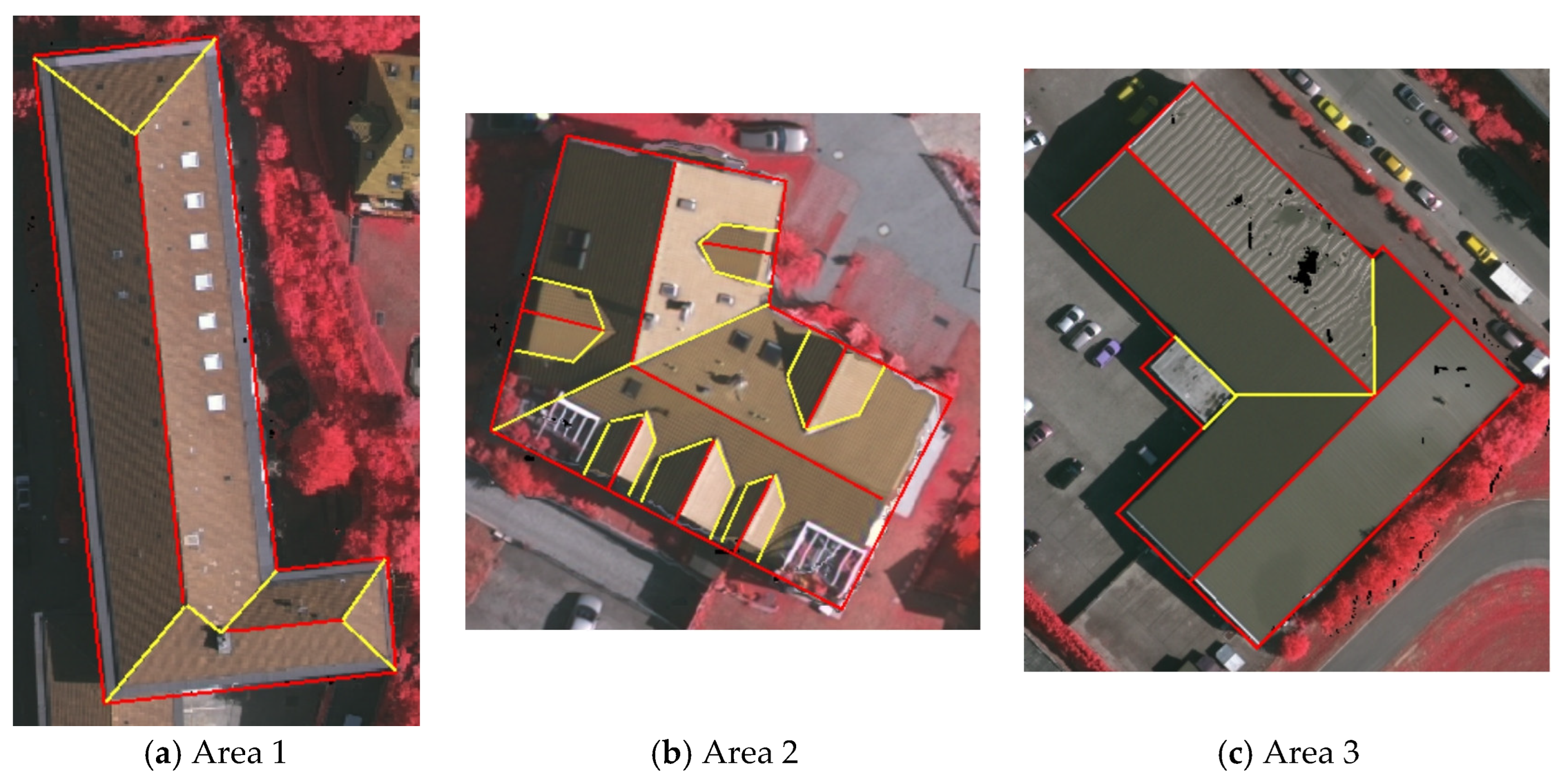
| Test Data | Area 1 | Area 2 | Area 3 | |
|---|---|---|---|---|
| Directional Component | ||||
| X | 0.291 | 0.509 | 0.668 | |
| Y | 0.398 | 0.295 | 0.410 | |
| H | 0.091 | 0.313 | 0.212 | |
Disclaimer/Publisher’s Note: The statements, opinions and data contained in all publications are solely those of the individual author(s) and contributor(s) and not of MDPI and/or the editor(s). MDPI and/or the editor(s) disclaim responsibility for any injury to people or property resulting from any ideas, methods, instructions or products referred to in the content. |
© 2023 by the authors. Licensee MDPI, Basel, Switzerland. This article is an open access article distributed under the terms and conditions of the Creative Commons Attribution (CC BY) license (https://creativecommons.org/licenses/by/4.0/).
Share and Cite
Cai, Z.; Ma, H.; Zhang, L. Extraction of Roof Feature Lines Based on Geometric Constraints from Airborne LiDAR Data. Remote Sens. 2023, 15, 5493. https://doi.org/10.3390/rs15235493
Cai Z, Ma H, Zhang L. Extraction of Roof Feature Lines Based on Geometric Constraints from Airborne LiDAR Data. Remote Sensing. 2023; 15(23):5493. https://doi.org/10.3390/rs15235493
Chicago/Turabian StyleCai, Zhan, Hongchao Ma, and Liang Zhang. 2023. "Extraction of Roof Feature Lines Based on Geometric Constraints from Airborne LiDAR Data" Remote Sensing 15, no. 23: 5493. https://doi.org/10.3390/rs15235493
APA StyleCai, Z., Ma, H., & Zhang, L. (2023). Extraction of Roof Feature Lines Based on Geometric Constraints from Airborne LiDAR Data. Remote Sensing, 15(23), 5493. https://doi.org/10.3390/rs15235493







